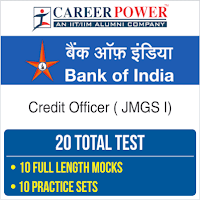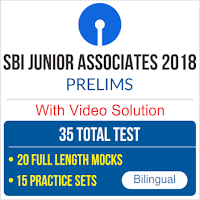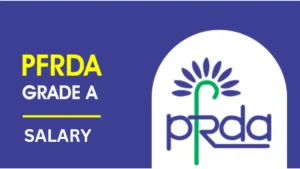Dear Aspirants,
Reasoning Ability is an onerous section. With the increasing complexity of questions, it becomes hard for one to give it the cold shoulder. Today is the Day 31 of the 60 Days SBI Clerk Prelims Study Plan. The only way to make the grade in this particular section in the forthcoming banking exams is to practice continuously with all your heart and soul. And, to let you practice with the best of the latest pattern questions, here is the Adda247 Reasoning Quiz based on the study plan and the exact same pattern of questions that are being asked in the exams.
P, Q, R, S, T, U, V and W are sitting around a square table facing the centre in such a way that four of them sit at four corners of the square while four sit in the middle of each of the four sides.
P sits second to right of U. U sits in the middle of one of the sides of the table. V, who does not sit at any of the corners of the table, sits second to the right of S. Only two people sit between S and Q (taken from one side.) R is not an immediate neighbour of V. W sits second to left of Q. T is not an immediate neighbour of V and U.
Q1. Who sits exactly between U and P?
(a) Q
(b) R
(c) T
(d) W
(e) None of these
Q2. How many persons sit between P and W when counted in anti-clockwise direction from P?
(a) None
(b) One
(c) Two
(d) Three
(e) Four
Q3. Four of the following five are alike in a certain way based on their seating positions in the above arrangement and so from a group. Which is the one that does not belong to that group?
(a) S
(b) U
(c) P
(d) T
(e) V
Q4. What is the position of U with respect to R?
(a) Third to the left
(b) Immediate to the right
(c) Second to the right
(d) Third to the right
(e) Immediate to the left
Q5. What will come in place of the question mark (?) based upon the given seating arrangement?
PT, TW, WU, ?
(a) UT
(b) WR
(c) US
(d) SQ
(e) UW
Directions (6-10): Study the following information carefully and answer the questions given below.
There are seven friends I, J, K, M, R, S and V, each of them aspires to become something. Each of them likes different colours viz. Blue, Yellow, Green, Violet, Maroon, Black and Red but not necessarily in the same order. Each of them wants to becomes Lawyer, Doctor, Engineer, Actor, Pilot, Army chief and Cricketer but not necessarily in the same order. R likes violet colour and wants to become a Doctor. K like Yellow colour and wants to become a cricketer. V does not like black colour and does not want to become an Engineer and Actor. The person, who likes maroon colour, wants to become an Actor, while the person who wants to be Pilot, likes blue colour. I likes red colour. S does not like green or black colour and he does not want to become an Actor. M wants to become a Lawyer. J does not want to become an Engineer or an Army chief.
Q6. Who does want to become an Army chief?
(a) S
(b) V
(c) I
(d) Data inadequate
(e) None of these
Q7. The person who wants to become a Lawyer likes which colour?
(a) Red
(b) Green
(c) Blue
(d) Data inadequate
(e) None of these
Q8. V wants to become a/an?
(a) Army chief
(b) Actor
(c) Engineer
(d) Pilot
(e) None of these
Q9. Who does like maroon colour?
(a) J
(b) S
(c) V
(d) Data inadequate
(e) None of these
Q10. Which of the following combinations of Person-Colour-Profession is correct?
(a) M-Blue-Lawyer
(b) I-Red-Cricketer
(c) S-Blue-Pilot
(d) J-Green-Actor
(e) V-Maroon-Actor
Directions: (11-15): Study the following information carefully and answer the questions given below:
Six girls – I, J, K, L, M and N are sitting in a row facing North and six boys – P, Q, R, S, T and U are sitting in a different row facing South, but not necessarily in the same order. Each girl in a row is facing exactly one boy from the other row. The following information is known about them.
P sits second to the right of the person who sits opposite J. J does not sit at any end of the row. K and L are immediate neighbors of J, and one of them sits at an extremes. M sits second to the left of L but not opposite R. P is a neighbor of R but is not opposite N. Neither Q nor T are adjacent to P. T is adjacent to either R or Q but not both. U is a neighbour of the person who sits opposite M.
Q11. Who sits opposite K?
(a) S
(b) P
(c) R
(d) Q
(e) T
Q12. Who sits second to the left of R?
(a) S
(b) T
(c) P
(d) Q
(e) U
Q13. If S and L interchange their positions, then who sits to the immediate left of L?
(a) U
(b) R
(c) P
(d) T
(e) Q
Q14. Four of the following five are alike in a certain way and so form a group. Find the one which does not belong to that group?
(a) U, I
(b) P, J
(c) L, S
(d) K, R
(e) L, T
Q15. Which of the following is true, according to the given information?
(a) U and K are at the extremes.
(b) R sits second to the right of S.
(c) T sits to the immediate right of Q.
(d) J sits second to the left of I.
(e) All the above






 GA Capsule for SBI Clerk Mains 2025, Dow...
GA Capsule for SBI Clerk Mains 2025, Dow...
 The Hindu Review October 2022: Download ...
The Hindu Review October 2022: Download ...
 PFRDA Grade A Salary 2025, Pay Scale, Jo...
PFRDA Grade A Salary 2025, Pay Scale, Jo...





